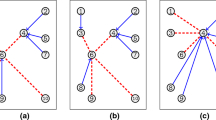Abstract
Given the demand between each origin-destination pair on a network, the planar hub location problem is to locate the multiple hubs anywhere on the plane and to assign the traffic to them so as to minimize the total travelling cost. The trips between any two points can be nonstop (no hubs used) or started by visiting any of the hubs. The travel cost between hubs is discounted with a factor. It is assumed that each point can be served by multiple hubs.
We propose a probabilistic clustering method for the planar hub-location problem which is analogous to the method of Iyigun and Ben-Israel (in Operations Research Letters 38, 207–214, 2010; Computational Optmization and Applications, 2013) for the solution of the multi-facility location problem. The proposed method is an iterative probabilistic approach assuming that all trips can be taken with probabilities that depend on the travel costs based on the hub locations. Each hub location is the convex combination of all data points and other hubs. The probabilities are updated at each iteration together with the hub locations. Computations stop when the hub locations stop moving.
Fermat-Weber problem and multi-facility location problem are the special cases of the proposed approach.






Similar content being viewed by others
References
Alumur, S., & Kara, B. Y. (2008). Network hub location problems: the state of the art. European Journal of Operational Research, 190, 1–21.
Aykin, T. (1988). On the location of hub facilities. Transportation Science, 22, 155–157.
Aykin, T. (1995). The hub location and routing problem. European Journal of Operational Research, 83, 200–219.
Aykin, T., & Brown, G. F. (1992). Interacting new facilities and location–allocation problem. Transportation Science, 26, 212–222.
Ben-Israel, A., & Iyigun, C. (2008). Probabilistic distance clustering. Journal of Classification, 25, 5–26.
Bryan, D. L. (1998). Extensions to the hub location problem: formulations and numerical examples. Geographical Analysis, 30, 315–330.
Bryan, D. L., & O’Kelly, M. E. (1999). Hub-and-spoke networks in air transportation: an analytical review. Journal of Regional Science, 39, 275–295.
Camargo, R. S., de Miranda, G., Luna, H. P. L., & Bender’s, H. P. L. (2008). Decomposition for the uncapacitated multiple allocation hub location problem. Computers & Operations Research, 35, 1047–1064.
Campbell, J. F. (1994a). Integer programming formulations of discrete hub location problems. European Journal of Operational Research, 72, 387–405.
Campbell, J. F. (1994b). Survey of network hub location. Studies in Locational Analysis, 6, 31–49.
Campbell, J. F., & O’Kelly, M. E. (2012). Twenty-five years of hub-location problem. Transportation Science, 46, 153–169.
Contreras, I., Cordeau, J.-F., & Laporte, G. (2011). Bender’s decomposition for large-scale uncapacitated hub location. Operations Research, 59, 1477–1490.
Cooper, L. (1964). Heuristic methods for location–allocation problems. SIAM Review, 6, 37–53.
Drezner, Z. (1984). The planar two-center and two-median problems. Transportation Science, 18, 351–361.
Drezner, Z., Klamroth, K., Schöbel, A., & Wesolowsky, G. O. (2002). The Weber problem. In Z. Drezner & H. W. Hamacher (Eds.), Facility location: applications and theory. Berlin: Springer.
Ernst, A. T., & Krishnamoorthy, M. (1996). Efficient algorithms for the uncapacitated single allocation p-hub median problem. Location Science, 4, 139–154.
Ernst, A. T., & Krishnamoorthy, M. (1998). Exact and heuristic algorithms for the uncapacitated multiple allocation p-hub median problems. European Journal of Operational Research, 104, 100–112.
Ernst, A. T., Hamacher, H., Jiang, H., Krishnamoorthy, M., & Woeginger, G. (2002). Heuristic algorithms for the uncapacitated hub center single allocation problem. Unpublished Report, CSIRO Mathematical and Information Sciences, Australia
Gavriliouk, E. O. (2009). Aggregation in hub location problems. Computers & Operations Research, 36, 3136–3142.
Hamacher, H. W., Labbé, M., Nickel, S., & Sonneborn, T. (2004). Adapting polyhedral properties from facility to hub location problems. Discrete Applied Mathematics, 145, 104–116.
Iyigun, C., & Ben-Israel, A. (2010). A generalized Weiszfeld method for the multi-facility location problem. Operations Research Letters, 38, 207–214.
Iyigun, C., & Ben-Israel, A. (2013). The multi-facility location problem: a probabilistic decomposition method. Computational Optmization and Applications, to appear.
Labbé, M., Yaman, H., & Gourdin, E. (2005). A branch and cut algorithm for hub location problems with single assignment. Mathematical Programming: Series A and B, 102(2), 371–405.
Megiddo, N., & Supowit, K. J. (1984). On the complexity of some common geometric location problems. SIAM Journal on Computing, 13, 182–196.
O’Kelly, M. E. (1986). The location of interacting hub facilities. Transportation Science, 20, 92–106.
O’Kelly, M. E. (1987). A quadratic integer program for the location of interacting hub facilities. European Journal of Operational Research, 32, 393–404.
O’Kelly, M. E. (1992). A clustering approach to the planar hub location problem. Annals of Operations Research, 40, 339–353.
O’Kelly, M. E., Bryan, D., Skorin-Kapov, D., & Skorin-Kapov, J. (1996). Hub network design with single and multiple allocation: a computational study. Location Science, 4, 125–138.
Späth, H. (1980). Cluster analysis algorithms for data reduction and classification. Upper Saddle River: Ellis Horwood.
Teboulle, M. (2007). A unified continuous optimization framework for center-based clustering methods. Machine Learning, 8, 65–102.
Vardi, Y., & Zhang, C.-H. (2001). A modified Weiszfeld algorithm for the Fermat–Weber location problem. Mathematical Programming Series A, 90, 559–566.
Weiszfeld, E. (1937). Sur le point par lequel la somme des distances de n points donnés est minimum. Tohoku Mathematical Journal, 43, 355–386.
Author information
Authors and Affiliations
Corresponding author
Rights and permissions
About this article
Cite this article
Iyigun, C. The planar hub location problem: a probabilistic clustering approach. Ann Oper Res 211, 193–207 (2013). https://doi.org/10.1007/s10479-013-1394-4
Published:
Issue Date:
DOI: https://doi.org/10.1007/s10479-013-1394-4




